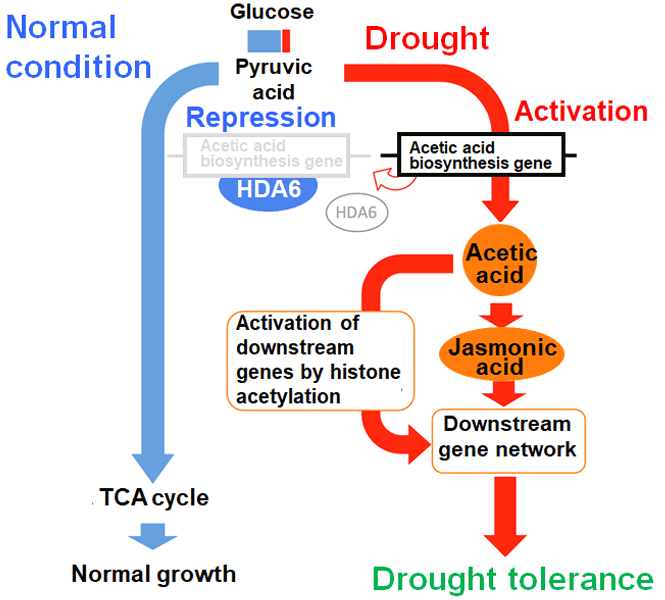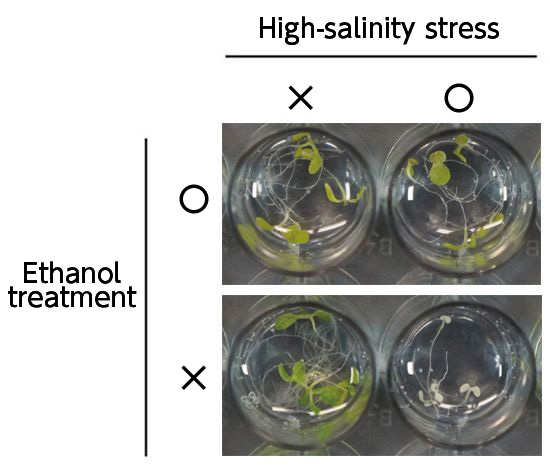Research Results
Enhancement of salt and drought tolerance via ethanol/acetic acid treatment
Improving stress-tolerance of agricultural cropsFY2019

- Motoaki Seki(Team Leader, RIKEN Center for Sustainable Resource Science)
- CREST
- Creation of essential technologies to utilize carbon dioxide as a resource through the enhancement of plant productivity and the exploitation of plant products “Enhancement of Environmental Stress Adaptation and Production of Useful Biomass through Understanding of Epigenome Regulatory Networks in Plants” Research Director (2013-2018)
Analyzing mechanisms with model plants
As part of CREST, a team led by the research director Motoaki Seki has performed various analyses using a model plant, Arabidopsis thaliana, and discovered that household sake and vinegar are useful in improving environmental stress adaptation and acclimation, exemplified by salt damage and drought.
To clarify the mechanism that improves salt tolerance, the team performed comprehensive gene expression analysis. They found that the expression of a gene cluster that removes reactive oxygen generated by salt stress increases through ethanol treatment, where ethanol is a component of sake. It also increases activity of ascorbate peroxidase, which breaks down hydrogen peroxide, a type of reactive oxygen.
The team examined how plant metabolism changes when Arabidopsis thaliana plants are exposed to drought stress. As a result, they discovered that, during a drought, not only is the glycolytic pathway*1—a central metabolic pathway in obtaining the energy necessary for life activities—suppressed, but biosynthesis of acetic acid, a component of vinegar, also increases. Furthermore, to elucidate the action mechanism of acetic acid, the team examined changes that take place when Arabidopsis thaliana plants were treated with acetic acid, and discovered that jasmonic acid*2 is synthesized, activating the downstream gene network involved in stress-tolerance, increasing tolerance against drought.
*1 The metabolic pathway found in most living creatures. It breaks down glucose into organic acids such as pyruvic acid, and converts the chemical energy of glucose into adenosine triphosphate (ATP), which is easier to use.
*2 A plant hormone associated with injury response, its functions include the ripening of fruits, aging, and signaling injury stress response.
A new drought tolerance mechanism of plants: the acetic acid-jasmonic acid pathway

During a normal condition when there is plenty of moisture, histone deacetylase HDA6 of Arabidopsis thaliana directly binds on the acetic acid biosynthesis genes, suppressing the biosynthesis of acetic acid. Therefore, the central metabolic pathway goes from glucose → pyruvic acid → TCA cycle (citric acid cycle). On the other hand, in response to drought, HDA6 detaches from the acetic acid biosynthesis genes, releasing the suppression of gene expression. As a result, acetic acid is synthesized in the plant. Synthesized acetic acid induces biosynthesis of jasmonic acid, a plant hormone that functions as injury response. Histone acetylation that uses acetic acid as the substrate activates the downstream gene network that functions as injury response, making the plant more tolerant to drought.
The challenge is sustainable food production
To maintain sustainable food production as the world's population increases, crops and fertilizers that are tolerant to environmental stresses such as salt damage and drought need to be developed.
Salt damage occurs due to the accumulation of salts via irrigation or along the coastal areas, and has a severe negative impact on agricultural crop production. When plants are exposed to stress from a high concentration of salts, it could interfere with the absorption of water from roots as well as photosynthesis. If reactive oxygen is further accumulated, cells could die. There are data that suggest that 20% of irrigated agricultural lands in the world experience salt damage.
Sudden drying conditions and droughts caused by environmental changes such as global warming are major problems on a global scale, related to decreases in the production of corn and wheat, and the expansion of desertification. The past method of increasing drought tolerance in plants involved gene recombination. However, production of gene recombination crops takes a significant amount of time and incurs high costs, and regulations varies between countries; thus, a simpler and cheaper technology to increase drought tolerance in plants is much desired.
Improved tolerance in rice
Our studies have shown that ethanol treatment improves salt tolerance, and acetic acid improves drought tolerance.
In fact, an experiment was conducted in which high salt stress was applied to untreated Arabidopsis thaliana and ethanol-treated Arabidopsis thaliana. The former turned white and withered. On the other hand, ethanol-treated Arabidopsis thaliana survived under the salt stress, indicating that the ethanol treatment suppresses accumulation of reactive oxygen. It was discovered that this is true for rice as well. These results indicated that ethanol treatment suppresses the accumulation of reactive oxygen and enhances salt tolerance in both monocots and dicots.
Next, various acid solutions were applied to Arabidopsis thaliana as drought treatments. It showed that only the samples treated with acetic acid had improved drought tolerance. It was confirmed that the drought tolerance of agricultural crops such as rice, corn, wheat, and rapeseed in addition to Arabidopsis thaliana could be improved by applying acetic acid. This discovery of the drought tolerance mechanism of plants via the acetic acid-jasmonic acid pathway is a major achievement of this study, and it is significant as it showed that this mechanism is evolutionary preserved in a wide range of plants.
Ethanol treatment improves salt tolerance

Arabidopsis thaliana turned white and withered under high salt stress. On the other hand, ethanol-treated plants survived under salt stress.
Potential of solving global problems
The present study discovered that by externally applying cheap and easily acquired compounds, the environmental stress-tolerance of plants improved in regard to salt damage and drought. By applying this result, a fertilizer that improves the salt tolerance of crops in areas where irrigation systems are financially difficult to install could be developed, increasing the yield.
It could also become a simple and low-cost agricultural technique to counter sudden drying conditions and droughts, where acetic acid is simply applied to plants without relying on gene recombination. In the future, the team plans to conduct experiments on actual crops in the field beyond the model plant. Continuing to study the drought tolerance mechanism of plants via the acetic acid-jasmonic acid pathway discovered in this study could lead to the discovery of further genes and materials, as well as elucidate the mechanism by which plants remember environmental stimulants.
The present study was published in newspapers and so on, including foreign media. Once the results have been put to a practical use, they could contribute to solving global food supply problems.
- Life Science
- Research Results
- Japanese
